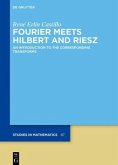Please note that the content of this book primarily consists of articles available from Wikipedia or other free sources online. In mathematics, the Riesz function is an entire function defined by Marcel Riesz in connection with the Riemann hypothesis, by means of the power series {rm Riesz}(x) = -sum_{k=1}^infty frac{(-x)^k}{(k-1)! zeta(2k)}. If we set F(x) = frac12 {rm Riesz}(4 pi^2 x) we may define it in terms of the coefficients of the Laurent series development of the hyperbolic (or equivalently, the ordinary) cotangent around zero. The Maclaurin series coefficients of F increase in absolute value until they reach their maximum at the 40th term of -1.753 x 1017. By the 109th term they have dropped below one in absolute value. Taking the first 1000 terms suffices to give a very accurate value for F(z) for z 9. However, this would require evaluating a polynomial of degree 1000 either using rational arithmetic with the coefficients of large numerator or denominator, or using floating point computations of over 100 digits. An alternative is to use the inverse Mellin transform defined above and numerically integrate. Neither approach is computationally easy.







